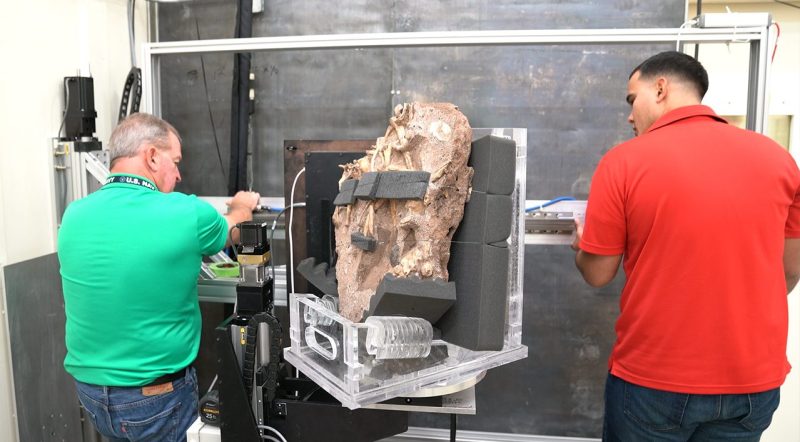A makerspace is a great place to use specialty tools that may be too expensive or large to own by oneself, but there are other perks that come with participation in that particular community. For example, all of the skills you’ve gained by using all that fancy equipment may make you employable in some very niche situations. [lukeiamyourfather] from the Dallas Makerspace recently found himself in just that situation, and was asked to image a two-million-year-old fossil.
The fossil was being placed into a CT machine for imaging, but was too thick to properly view. These things tend to be fragile, so he spent some time laser cutting an acrylic stand in order to image the fossil vertically instead of horizontally. Everything that wasn’t fossil had to be non-conductive for the CT machine, so lots of fishing line and foam was used as well. After the imaging was done, he was also asked to 3D print a model for a display in the museum.
This is all going on at the Perot Museum of Nature and Science if you happen to be in the Dallas area. It’s interesting to see these skills put to use out in the wild as well, especially for something as rare and fragile as studying an old fossil. Also, if you’d like to see if your local makerspace measures up to the Dallas makerspace, we featured a tour of it back in 2014, although they have probably made some updates since then.















Wouldn’t a cardboard box with packing foam have done the same?
Or Styrofoam and hot glue: it’s used for quick fixtures in industrial scanning.
It only takes minutes to cut it with a jigsaw, and with ribs it’s very rigid.
When you have a hammer, everything looks like a nail.
Yeah, lets put a two million year old fossil in an old FedEx box held together with tape and hot-glue.
The bigger story was that they used the scan data to create better visualizations of what was inside as well as 3D printing the caves where the fossil was found.
They ship them from the dig covered in plaster cast and plywood. Just cause it didn’t involve lasers or hi-tech doesn’t mean it isn’t sufficient
I’m guessing that the rock is quite heavy based on the thickness of the acrylic used.
Isn’t “old fossil” redundant? (because the process of fossilization by definition takes enough time that anything that has been fossilized is quite old by the time it can be called a fossil).
Well, it could be a new Fossil watch!
B^)
“Everything that wasn’t fossil had to be non-conductive for the CT machine”
Hunh? X-ray Computed Tomography machines don’t give a flying hoot about material conductivity. (Maybe are you confusing CT with MRI?)
More likely they used acrylic because it’s less attenuating to x-rays than most conductive material (metals…) and will produce fewer imaging artifacts (“beam hardening” and “photon starved” are the terms to search for if you’re interested in learning more).
That, or maybe their laser cutter prefers to cut acrylic…
Plywood and a jigsaw would have worked just as well, but a hack is a hack.
From the title, I expected this article to be about a company offering employment opportunities to those at a makerspace.
Which makes sense to get employees that have some practical experience.
But then I read the article. ;P
#metoo
You should see Dallas Makerspace now! They’ve leased the neighboring space and have expanded to ~36,000 sq ft. in size.